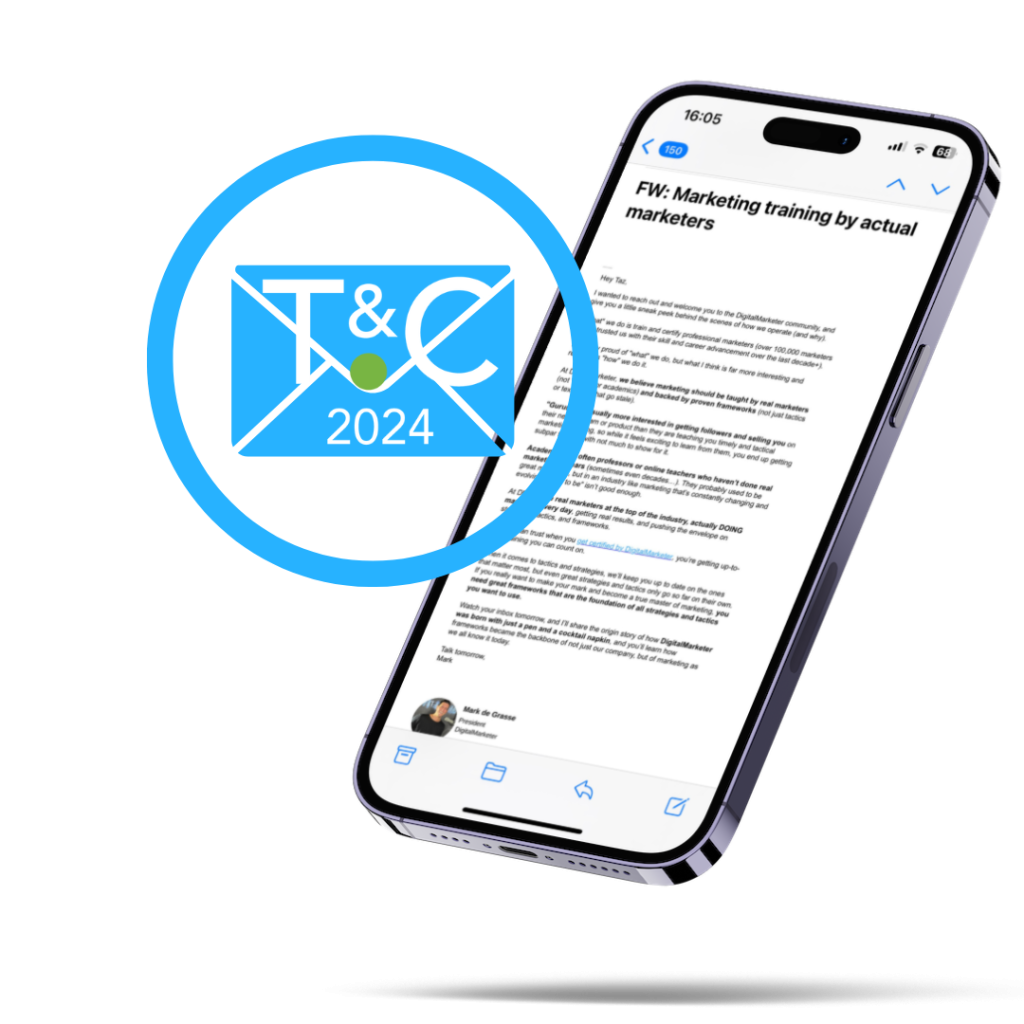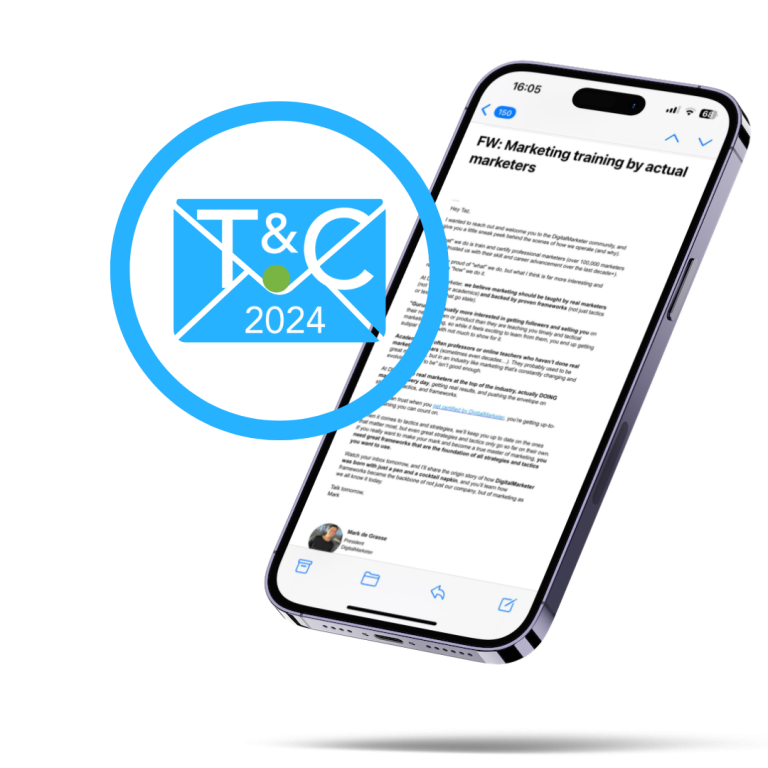In this interview, I (virtually) sat down with Michelle Barnum Smith to hear more about her session at Traffic & Conversion Summit.
Michelle is a Facebook messenger bot expert for Amazon and ecommerce sellers at Your Marketing Therapy, and her history with T&C goes way back. This year she’s scheduled to speak with one of her heroes.
I was watching Marcus Lemonis on his show, and I was just so inspired by him. He’s such a business leader. He’s such a brilliant mind, you know? Like… how cool is he? I could never be something like that. (You know those thoughts and voices we have in our head.) And — her voice breaks — here I am. Fast forward to 2020, and I’m speaking at the same event that he is? *Laughs* How is that even possible, you know? Like that is just a huge testament to the power that we have inside of ourselves to grow, and to change, and to become.
Michelle Barnum Smith
Michelle also drops some serious insider knowledge for ecommerce and Amazon sellers.
Michelle shares the strategies you need to know to rank on Amazon, including:
- How to apply the keyword “halo effect”
- How to harvest the “low-hanging” keyword fruit
- “Inventory protection” campaigns
Bethany Cowan: Can you tell us a little bit about what your session is about?
Michelle Barnum Smith: Really when it comes to succeeding on Amazon everything comes down to how a seller’s products are positioned for their target keywords. Amazon is a pain-based marketplace in the sense that people come with a pain, whether it’s a literal pain or a figurative pain. And they go and they type in a series of words into the search bar and solutions magically appear in the results. And if you don’t have a good position for that pain, then nobody’s going to see you! It’s like Google. If you type in the search bar and your results are not on page one then you might as well be dead. So everything is about position and ranking campaigns are all about helping you gain that position for your target keywords.
Bethany: Have you noticed any changes that have come online in the last few weeks or months that really dig into how those changes happen in ranking? Or is everything pretty much the same principles?
Michelle: No, nothing’s ever the same with Amazon. I liken it to, it’s not a boxing match. At least a boxing match you have one opponent and can see your opponent coming. Amazon is like a bar fight or a brawl where you don’t know where the next punch might be coming from. Not only do changes happen with competitors hacking you, Amazon’s constantly making changes and just this last week a very significant change rolled out in the form of inventory. Basically Amazon had a rough go of doing fulfillment. They’ve rolled out inventory restrictions for Amazon sellers. It used to be that you could ship in an entire order of products, maybe 1000-5000 units. And just this week Amazon’s basically imposed limits. And you know for good reason! They don’t want to be a warehouse for old, not selling products that stack up and gather dust. But where this really hurts is for new product launches. And we’re heading into (I mean I know it’s july, but amazon sellers are already living as if it’s Q4). Q4 is obviously the biggest sales time of the year. And so all these changes that Amazon is making, they’re doing so in preparation for the big influx in Q4. And they’re planning Prime Day, they moved Prime Day essentially from July (should have been this week) to some time in October. They haven’t announced when. All these inventory limits that they’re placing, especially on new products. Basically any new product can only have 183 units in stock. And that is just pure insanity for most sellers. And we’re talking even big sellers are only limited to 183 units. And what happens is, even if you don’t run ranking campaigns, even if you just organically get to the top of page one, what happens then is you play the battle of going in and out of stock. And amazon’s basically saying like, oh if you sell 20 units, then you can put 20 units back in stock. You can’t ever send more than the limit. At least that’s what’s occurring right now. And we don’t have any kind of visibility in how long that’s going to last. And so existing products, if you have existing inventory in stock, you’re fine. But if you have new product launches, you have to be very very cautious in how you’re going to bring that product to market basically. So that just happened two days ago.
Bethany: Is there a specific niche that gets crazy results from working with you, or is this all verticals, any type of product across Amazon?
Michelle: It’s less about a niche and more about the type of seller. So it really has to be the seller’s that this performs best for are what we call private label sellers, or you know people who have their own brands. It doesn’t work well for a wholesaler (if it’s exclusive wholesale it’ll work) but not any kind of wholesaler arbitrage or even 1P amazon vendor clients. These clients don’t work for them just because there’s too many variables. But if it’s a private label seller, and I won’t even say FBA at this point, because FBA deals with all of these inventory issues, but you know really what it comes down to is that any amazon seller can benefit from these strategies. I’ve been doing this since 2017. It’s only 3 years but a lot has happened.
Bethany: In Amazon years, that’s like 30 years.
Michelle: Exactly, it’s a very different world than it was even 6 months ago. Any seller can benefit, any private label seller can benefit from the strategies that we’ll talk about.
Bethany: What would you say would be the 1 or 2 takeaways that you really want your audience to get out of your session?
Michelle: I’m known as a ManyChat expert. And while that’s great and I’m good at ManyChat, what’s more important is strategy. ManyChat is a really great tool and platform but it’s just a tool. And just like any tool, you put a bad strategy into it and you get a bad result out of it. It’s like a recipe to a certain degree. I think some people are just looking for a magic wand. The reality is that on Amazon, there’s no such thing. So it’s really important to go into any kind of campaign with a really solid strategy. And where I tell every seller to start is with their keyword research. They should spend a good amount of time (any time I start a consulting project with a client or a coaching call with a client, we spend the majority of the time on that call in keyword research). Because the keywords that you’re trying to position yourself for are going to make or break your campaign. And especially with inventory sensitivity, there’s all sorts of inventory sensitivity. But in March it was supply chain because China had shut down, and quite frankly the supply chain is still being affected. But then inventory suppressions in and out that happened in April, and now these new inventory limits that are in place makes inventory sensitivity such an important thing to consider when you are running any kind of campaign. And so keyword research and understanding the keywords that you’re going to target for your campaign are so important. And previously people would go after keywords that their competitors are ranking for, but now I think it’s more important to look at the keywords, especially if you’re an existing listing, that you’re already ranking for that are low-hanging fruit. And keywords that I call where you have an opportunity for “halo effect.” which is you rank for one, you target one keywords, and you get multiple benefits from multiple keywords because they have so many shared words. It’s so important now more than ever to be very strategic with keywords and lead with that. And then pick a campaign and a ManyChat template to help you accomplish that.
Bethany: What’s a major marketing win you’ve experienced this year, whether for you or a client?
Michelle: That’s kind of a tough question because I think to a certain degree, especially these last couple months, you kind of put your head down and go into survival mode. You’re slogging, putting one foot in front of the other, and you’re just moving forward. Every once in a while you pull your head up and go, wow that actually went well. That surprised me! There are those kinds of moments. One of the good things that has happened in the last several months is like I’ve been developing and testing campaigns to help protect inventory levels so that sellers don’t have to run quite as aggressive campaigns and still get really great ranking results and that has been something that we’ve been beta testing for the last three months. And we’ve been seeing some really good results. And so that has been good.
Bethany: So how is that different from what you’ve always done?
Michelle: A typical ranking campaign is a lot like riding a bike. When you’re learning how to ride a bike (I have little kids so we’re teaching them how to ride a bike without training wheels). When you’re running a ranking campaign, the idea is to match the speed or the sales velocity of the leaders on page one. So just like riding a bike, you’re pushing your kid to try to gain momentum. And without momentum, what happens? You fall over. It doesn’t matter how shiny the bike is, how cute the kid is. Without that momentum, it’s all going to come crashing down. So ranking campaigns are all about helping sellers build up that sales velocity to reach a similar sales velocity as the leaders on the page for their keywords. And what that looks like often is running sales on their products to help generate that velocity. But what that results in is a lot of inventory that is lost to these campaigns. Basically you’re just burning through a certain portion of your inventory to get it ranked. With all of this inventory craziness, it is so important now more than ever to protect that inventory and be efficient with your ranking campaigns. There’s lots of other elements that go into getting and staying ranked, but the first step is to get that velocity. And then from there reviews and things like that. So the campaigns that we’ve been working on have been basically trying to mimic a sale without it having to result in a sale. And it sounds black hat, but it’s completely not and it’s within the terms of service. So thats what weve been experimenting with and testing how many full sales we actually need compared to things that look like sales but don’t actually use up the inventory.
Bethany: To keep playing off of your riding a bike analogy, if you were to talk about the energy that it takes or the “fuel” that it takes of you pushing your kid, or the kid pedaling like crazy, you want to build that velocity without totally burning out the fuel you’re using. The fuel in this instance being that inventory.
Michelle: With Amazon it’s adapt or die on a daily basis. As amazing as the opportunity is for Amazon sellers, it’s no cakewalk for sure. The number 1 feature any business owner has to have but especially an Amazon business owner is resilience. And taking what that day has to offer sometimes it’s good and sometimes it’s not. It’s really bad. And you just have to keep moving forward and that’s just the reality. And I feel like my role and how I can help sellers is to give them hope and to keep finding solutions and experimenting with solutions. That’s just the reality in the space, and I think in marketing in general, is that marketing is an ever-changing beast there’s always new tools in the marketplace, there’s new things to try, there’s new strategies to try, one of my best friends is an accountant. And I envy her sometimes because accounting never changes! It just stays the same all the time. But marketing is constantly changing. And especially marketing in the amazon world is a constant change as well. So I hope to serve the Amazon sellers by staying on top of what’s working, what’s not working, and do my best to give them solutions to help them adapt.
Bethany: What’s something that you wish you had done sooner?
Michelle: There’s different ways that I monetize what I do. And I think as a business owner, As Gary V would say, you always have to be analyzing your business as if you’re going to put yourself out of business every day. “What is the market going to do to make me irrelevant?” Sometimes to my own detriment I focus on what needs to be done that day and putting my head down, especially in the recent months, just putting my head down and getting things done, and sometimes you have to be more forward thinking and look up and be like, okay what’s coming? And how do I need to adapt to that? I’m really good at doing that for my clients, I’m not so great at doing that for myself. I feel like that’s what it means to be in business. You’re really good at doing things for other people but really crappy at doing things for yourself.
Especially when it’s a high-intensity time and so you don’t feel you can take the time away because strategy requires you taking time away from the fires. And just letting them burn sometimes. And what i’ve been doing lately is spending time – I live in utah so we have access to beautiful mountains here and nature. And we’re not in lockdown, so me and my family have been doing more to go camping, and literally get away from everything. We social distance to the extreme in that regard. We’re up in the mountains, there’s no service, no internet access, so it kind of gives me time to reconnect with my larger purpose. Being a wife and a mother and contributing to my family and making sure that they’re that that connection is there. I feel like that grounding is really important to come back to help – to help me come back with not only fresh ideas and new strategies, but also to remember why I’m doing what I’m doing. As much as I love my amazon sellers, I love my family more. As much as we have to do to survive these days in difficult times, we also need to thrive and find ways to do so and not put that stress and that burden and distribute it onto our children because that’s the last thing that they need right now.
Bethany: Have you spotted any kind of emerging channel or new opportunity that sellers need to look out for, or any marketers in general need to pay attention to looking ahead of 2020?
Michelle: The biggest thing that I’m working on with Amazon sellers right now is using Amazon as an acquisition channel for diversifying their income. So what that looks like is having your first sale, or even second sale, through Amazon, but then 3rd sale, 4th sale, upsell, cross sell, those kind of opportunities going direct. And developing a relationship directly with your buyers. Because right now the buyers are buying your product but they are Amazon customers, right? When we get those Amazon boxes, even as a consumer myself, I’m not thinking about the brands inside of that box. I’m thinking about my relationship with Amazon. And so if a seller has multiple products that are complimentary in a space, that can be used to deepen the relationships with their buyers. I think that’s the next iteration sellers need to be thinking about. Not just winning the sale and winning the daily battle. You win the sale, you win the battle. You win the customer, you win the war. That is the biggest thing that I am focusing on moving forward, because obviously the Amazon marketplace is, you’re playing in someone else’s arena. But if you can use amazon as an acquisition channel, and this intimidates a lot of sellers, the idea of developing a direct channel, because Amazon provides so much traffic that you get really addicted to that. So the idea of diversifying traffic sources and trying to figure out how to run a profitable facebook ad campaign is really kind of overwhelming. And many try it and just quit because Amazon traffic is just so much easier. The sales just kind of come in with very little effort once you’re positioned. So my whole strategy is get positioned, do those ranking campaigns and get those reviews coming in, and then think about how you can start to acquire those customers directly and deepen your relationship so that you can have the power of that traffic source serving your direct business as well.
Bethany: What are some of the things you do or coach people to do, once they’ve that initial sale on Amazon, to build that relationship and bring the customer into the fold?
Michelle: Let’s take a step back and say that not all niches are going to work well for this strategy. There are some sellers out there that it’s really truly a one-and-done type of product. And unless you’re going to develop products with this purpose in mind, then it really is kind of like, there’s nowhere to go from the initial purchase. But if you are in the consumable space, really any kind of consumable, especially food, and supplements, and items that get used up, or that you have other flavors in, or other consumables that you can cross sell to, those do very very well with this strategy. And I’ve worked with many sellers in the space now on beta testing these types of strategies and it does very well. Because the reality is once again, people go to amazon – and lets just use the example of they’re buying some body wash – and so they type in a scent that they like – “lavender body wash.” and so all the search results that come up are specific to that search term. And the product that they select, they buy it, and they have no idea that that brand might have other products. They might have facial creams. They might have body lotions. They might have shampoo and conditioner that the consumer only knows they only bought lavender body wash from that seller or that brand. And so this is the opportunity to introduce other products – like hey we do all this other stuff! Snd diversify those offerings. So first it’s really important to understand that this strategy has certain niches that it works better in than others.
And then it’s really about identifying like, well how do we find those buyers? You know how do we access those buyers? And there’s different strategies for doing that and I’ll say there’s caveats for the type of strategies that you’re going to use. I Don’t think we have time to go into every little thing. … I hate to dangle the carrot, but there’s really a lot of nuances. But I will say for sellers, who have 5-10 related products, they really need to start thinking about how to use this strategy in moving forward. And if you’re not already in the consumable space, looking at how you can diversify to provide offerings to take advantage of this, because I will say that subscribe and save and monthly recurring revenue is like, really sexy compared to fighting the daily battle on Amazon. When you know that you have 10k a month, 20k a month, 50k a month in recurring revenue and can expect that, man that takes an edge off of winning the daily battle on amazon.
Bethany: What has been the most rewarding experience for you in your career as a business owner, coach, and consultant thus far?
Michelle: *Laughs* You know, I hate to kiss up to you guys, but I’m a marketing professional. I’ve been marketing for 20 years, and I’ve been a DigitalMarketer fan for pretty much all of those years! I’ve attended Traffic & Conversion Summit, and honestly… When I was able to speak at Traffic & Conversion Summit in 2019, it was such a — I’m going to get emotional. It was such a validation of all the hard work that I’ve put in. There are so many marketers out there who work so hard for their clients who may never have that opportunity! So to be selected and chosen for that kind of honor is huge to me.
Bethany: People always joke about T&C that it’s the only place in the world where marketers go to cry. It’s the place where marketers really come home. I love hearing that story and I hope that you saying that is an inspiration to people. You come to T&C, and at some point, you’re brand new. Everybody starts marketing somewhere, some time. Everyone’s new at some point. The idea that you can kind of come into this community and the first year it’s like drinking out of a firehose. There’s literally so much strategy that you could take one year of content at T&C, apply it every day for the next 20 years, and you still wouldn’t get to all the different strategies people have covered. And that’s really the power of the community that we have. It’s so inspiring to hear that, maybe at one point, you were in that place.
Michelle: Oh I was definitely in that place. *Laughs.* I remember when you guys announced that Marcus Lemonis was speaking. Three years before that, I just had my second daughter. I was nursing, doing the late night feedings, living in sweatpants before it was COVID-cool… I hadn’t showered in who knows how long, and I was watching The Profit. I was watching Marcus Lemonis on his show, and I was just so inspired by him. He’s such a business leader. He’s such a brilliant mind, you know? Like… how cool is he? I could never be something like that. (You know those thoughts and voices we have in our head.) And — her voice breaks — here I am. Fast forward to 2020, and I’m speaking at the same event that he is? *Laughs* How is that even possible, you know? Like that is just a huge testament to the power that we have inside of ourselves to grow, and to change, and to become.






